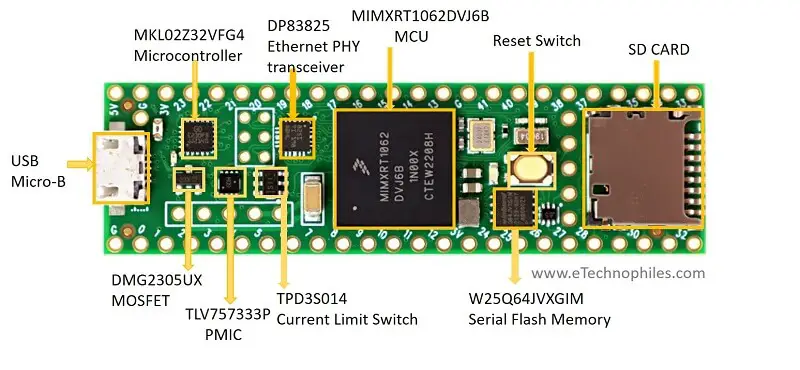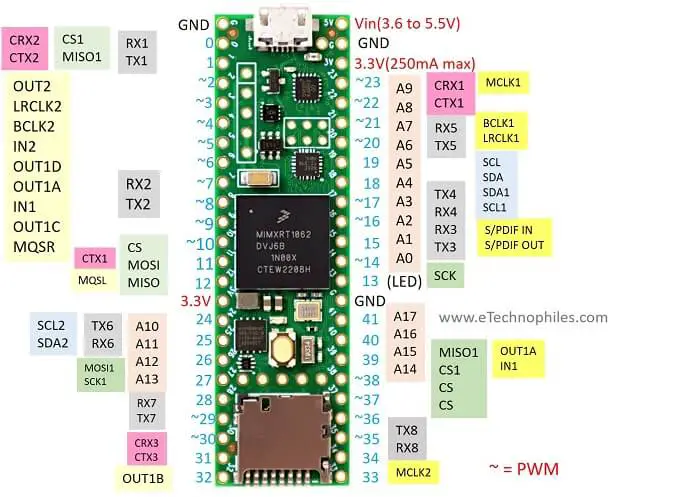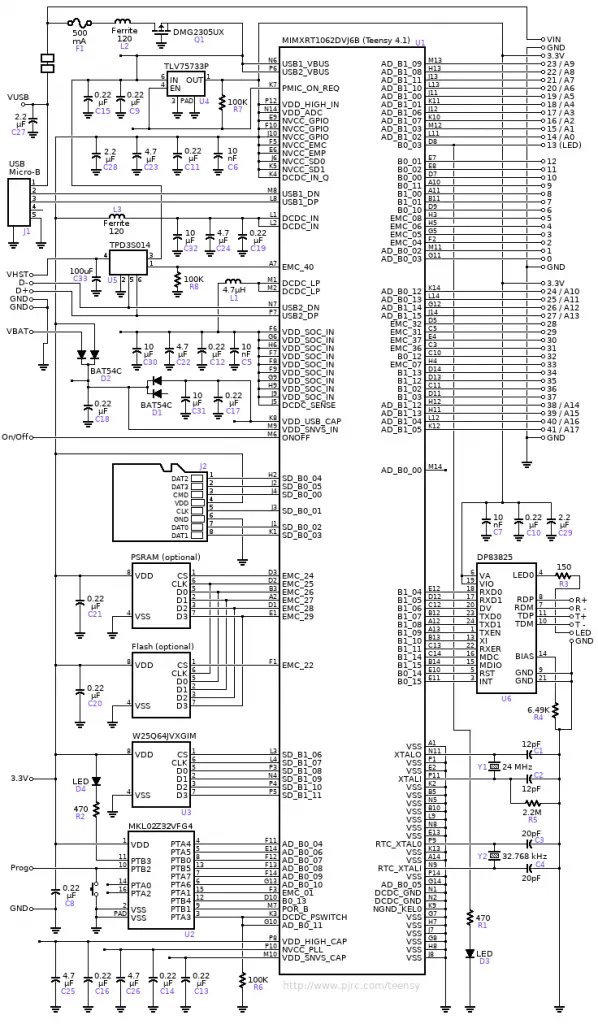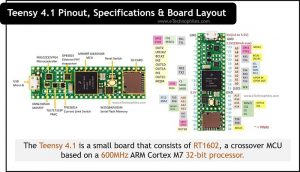Last updated on March 16th, 2024 at 04:15 pm
The Teensy 4.1 is a small board (2.4′′ x 0.7′′) available at a low price ($26.85 at the time of purchase). This board costs about the same as an Arduino Uno and less than an Arduino Mega, but it offers significantly higher performance than both boards. The thing that makes this board so powerful is RT1602, a crossover MCU based on a 600MHz ARM Cortex M7 32-bit processor.
The Board comes with 1024 KB ram, 7936 KB flash memory, and 4KB EEPROM. There are 18 analog pins and 55 digital I/O pins on board out of which 35 pins support pulse width modulation. This board supports CAN, I2C, and SPI serial communication protocols.
If we compare this board with the Teensy 4.0, we can find Teensy 4.1 includes an Ethernet controller and an Ethernet PHY chip. Only an RJ45 mag jack kit is required to connect an Ethernet cable. Teensy 4.1 also has an onboard SD card slot for SD cards which makes this board unique from other Teensy Family boards.
Table of Contents
Board Layout

MCU (MIMXRT1062DVJ6B)
The MCU in Teensy 4.1 board is from the i.MX RT1060 processor family that features NXP’s advanced implementation of the Arm Cortex-M7 core. It runs at speeds of up to 600 MHz to provide high CPU performance and the best real-time response.
On-chip RAM for the i.MX RT1060 processor is 1 MB. The first 512 KB can be configured as general-purpose on-chip RAM, while the second 512 KB is general-purpose on-chip RAM.
Microcontroller (MKL02Z32VFG4)
This is the secondary microcontroller present on the Teensy 4.1 board. It increases the overall efficiency and performance of the board. It has a small size, ultrasmall package, and energy-efficient ARM Cortex-M0+ 32-bit performance. This microcontroller provides:
- Run power consumption as low as 36 A/MHz in very low power run mode
- Static power consumption down to 2 μA with full state retention(fast wake-up address) and 4 μs wakeup
- Ultra-efficient Cortex-M0+ processor running at up to 48 MHz with industry-leading throughput
- Memory options include up to 32 KB flash and 4 KB RAM
Transreceiver (DP83825)
It is a very low-power Ethernet Physical Layer transceiver. Over CAT5e cable, it supports a reach of up to 150 meters.
SD CARD
SD card slot is present on the development board for SD card support.
Mosfet (DMG2305UX)
It is a P-Channel Enhancement Mosfet. This MOSFET is optimized for high-efficiency power management applications by minimizing on-state resistance while maintaining superior switching performance.
Regulator (TLV757333P)
It is a low-dropout regulator (LDO). The TLV757P is designed for a wide range of applications, with an input voltage range of 1.45 V to 5.5 V. To support the lower core voltages of modern MCUs, the device is available in fixed output voltages ranging from 0.6 V to 5 V to reduce cost and board’s size.
TPD3S014
The TPD3S0x4s are integrated devices that feature a current-limited load switch and a two-channel transient voltage suppressor (TVS) based electrostatic discharge (ESD) protection diode array for USB interfaces.
Serial Flash Memory (W25Q64JVXGIM)
It is an external Serial Flash memory used with the central MCU. It provides external flash memory to the board.
Read also: Teensy 3.2 Pinout, Specifications & Board Layout
Specifications
The specifications of Teensy 4.1 are given in the table below:
| No. | Specifications | Description |
| 1 | MCU | MIMXRT1062DVJ6B ARM Cortex-M7 MCU |
| 2 | RAM | 1024K RAM (From which 512 is tightly coupled) |
| 3 | Flash Memory | 7936 KB |
| 4 | EEPROM | 4 KB |
| 5 | USB Port | 2 USB ports are available and the speed of both is 480 Mbit/sec |
| 6 | CAN Bus | 3 CAN Bus present |
| 7 | I2S | 2 I2S Digital Audio |
| 8 | SPI | 3 SPI ports are available |
| 9 | I2C | 3 I2C ports are available |
| 10 | Serial ports | 8 serial ports are available |
| 11 | SD Card Port | 1 SD card port is available |
| 12 | Digital I/O Pins | 55 |
| 13 | PWM Pins | 35 |
| 14 | Analog Pins | 18 |
| 15 | DMA | 32 general-purpose DMA channels |
| 16 | RTC | Yes, RTC is available in Teensy 4.1 |
| 17 | DC Current per I/O pin | 10mA |
| 18 | Operating voltage and I/O Voltage compatibility | 3.3V |
| 19 | Cryptographic Acceleration | Yes, Cryptographic Acceleration is present in Teensy 4.1 |
Pinout
Teensy 4.1 has a total of 55 input/output signal pins. 42 are easily accessible when used with a solderless breadboard. In teensy 4.1, 35 PWM pin support and 18 analog pins are present. Teensy 4.1 is enabled with SPI, CAN, and I2C serial communication protocols.

| Pin Category | Pin Name | Description |
| Power | VIN, 3.3V, GND | VIN – This pin may receive 5V, when USB power is not used (3.6 to 5.5V) 3.3V – The onboard regulator’s regulated output voltage (250mA max) GND stands for ground pins. |
| Analog Pins | A0 – A17 | Pins A0 to A17 can be used as analog input pins with a resolution of 12 bits |
| I/O Pins | D0 – D41 | 55 Digital I/O pins are available |
| PWM pins | D0 – D15 D18 – D19 D22 – D25 D28 – D29 D33 D36 – D37 | 35 PWM Output pins |
| Inbuilt LED | D13 | Inbuilt GPIO indicator LED |
| Serial Com. | TX1 , RX1 Pin 1,0 TX2 , RX2 Pin 8,7 TX3 , RX3 Pin 14,15 TX4 , RX4 Pin 17,16 TX5 , RX5 Pin 20,21 TX6 , RX6 Pin 24,25 TX7 , RX7 Pin 29,28 TX8 , RX8 Pin 35,34 | 8 serial ports are available |
| SPI | CS, MOSI, MISO, SCK Pin 10,11,12,13 CS1 , MOSI1 , MISO1 , SCK1 Pin 0,26,1,27 CS2, MOSI2 , MISO2 , SCK2 Pin 44,43,42,45 | Serial Peripheral Interface Port |
| I2C | SCL, SDA Pin19,18 SCL1, SDA1 Pin 16,17 SCL2, SDA2 Pin 24,25 | Inter-Integrated Circuit communication port |
| CAN Bus | CTX1, CRX1 Pin 22,23 CTX2, CRX2 Pin 1,0 CTX3, CRX3 Pin 31,30 | CAN bus (1 with CAN FD) |
- Terminal Block Breakout Board Module for Teensy 4.1, Screw Mount Version. With the breakout board, you can easily extend Teensy 4.1 projects to industrial control, home automation or other applications.
- With 112 DIY solder pads on board, pitch 2.54mm, hole 0.8mm, you can use these pads to install soldered some electronic components for you need.
Schematic

Teensy 4.1 has a 32-bit ARM Cortex-M7 CPU running at 600MHz as the main SMD MCU microcontroller. While the secondary microcontroller is Cortex-M0+ Ultra-Low Power MCU with 32KB Flash and 4KB SRAM. This controller is used here for signal multiplexing, decreasing wake-up time, and increasing the overall performance of the Teensy 4.1 development board.
It has a flash memory IC for increasing flash memory size. FLASH and PSRAM boosts the performance of the board. A very low-power Ethernet Physical Layer transceiver provides ethernet support to the Teensy 4.1 board.
It uses a USB Micro-B type socket to connect the USB cable for programming, and to power up the board.
How to power Teensy 4.1?
USB Power
Teensy is normally powered by a PC or USB hub via a USB cable. The USB power is delivered to the VUSB pin, which is linked to VIN.
VIN Pin
When not using USB power, 5V power can be applied to the VIN pin. Because VIN and VUSB are linked, power should not be applied to VIN while using a USB cable.
3.3V Power
The Teensy 4.1 includes a voltage regulator that reduces the 5V VUSB / VIN power to 3.3V for use by the main processor and most other components. The 3.3V pin can be used to power additional circuitry. The maximum recommended external 3.3V usage is 250mA.
VBAT
A 3-volt coin cell can be connected to VBAT and GND to allow the RTC to keep track of the date and time even when the power is turned off. A CR2032-type battery is recommended, but other 3V coin cells can be used as well.
FAQs
Is Teensy 4.1 is a substitute for other development boards?
Yes, teensy 4.1 is a more powerful board than any other board available in this price range. Teensy 4.1 have ethernet as well as SD card slot support which increases the features board. Its MCU’s clock frequency is 600 MHz so we can perform many high-speed operations in very less time.
Is Teensy 4.1 better for audio projects?
Yes, teensy 4.1 is better for audio projects because it supports I2S and TDM internally. I2S and TDM are digital data streaming interfaces particularly appropriate for the transmission of audio data. Using PJRC’s audio library tool you can make many cool projects and also in very less time because of their graphic user interface for this library.
How to connect Teensy 4.1 with ethernet?
For connecting ethernet with teensy 4.1 two ways are available. One is using the RJ45 magjack kit while the other is using Wiznet W5500 and Wiz820 shield, connected to the SPI port.
Projects using Teensy 4.1
Teensy Drum Sample Player
Using teensy boards you can make many cool projects related to Audio. You may watch this tutorial video for more such cool projects.

